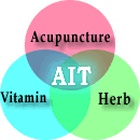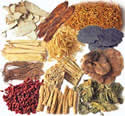Chinese
herb
Radix
Bupleuri £¨Chai Hu, ñº£©
Source
Root of Bupleurum chinense DC. and the root or herb of B. scorzonerifolium
Wilid., family Umbelliferae.
Characteristics
A woody tap root system. Root stock enlarged, with remainders of stem
bases and rootlets. Outer surface black-brown. Ligneous part tenacious,
appearing fibrous or sliced when broken. B. scorzonerifolium: Root
sparsely branching. Outer surface brown; section surface not showing
fibrous; leaf linear-lanceolate. Both are bitter and acrid in taste,
slightly cold in nature, and attributive to pericardium, liver, triple-jiao
and gallbladder channels.
Indication
1. Expel the exogenous evil from the body surface, let off heat, and
clear away evil heat from shaoyang channel: For common cold with fever,
alternating episodes of chilliness and fever, malaria, usually used
together with Radix Scuteliariae.
2. Disperse the stagnated liver energy: For stagnation of liver energy
with hypochondriac pain, dizziness, mental depression and irregular
menstruation, usually used together with Radix Paeoniae Alba
3. Life up yang-energy: For visceroptosis, used together with Radix
Astragali seu Hedysari and Radix Codonopsis Pliosukie.
Pharmacological
Action
Saikosaponin is the active component.
1. Increasing the hypnotic effect of barbital in mice.
2. Analgesic, anti-inflammatory, antitussive and antipyretic.
3. Decreasing the damage of liver by CCl4 and increasing biliary secretion
in rats.
4. Hemolytic in vitro.
5. Lowering blood pressure in rabbits and inhibiting the heart of
frog and guinea-pigs in vitro.
Administraion
Decoction: 3-9g. Injection: 3-5 ml IM 1-2 times daily for fever.
Radix
Isatidis (Ban
Lan Gen, °åÀº¸ù)
Source
Root of Isatis tinctoria L., family Cruciferae, or Baphicacanthus
cusia (Nees) Brem, family Acanthaceae.
Characteristics
L tinctoria: Root slender-linear; 10-20 cm long and 0.5-1.0 cm in
diameter; root stock marked by petiole basal traces and dense tuberdes;
epidermis grey-yellow, with transversely long lenticels. B. cusia:
Root irregularly branching, unequal in length, 0.5-1.0 cm in diameter,
with grey-blue and lustrous surface. Bitter in taste, cold in nature,
and attributive t9 heart and lung channels.
Indication
Similar to Folium Isatidis, but lesser bitter in flavour and cold
in nature, usually used for seasonal febrile diseases, pestilence,
mumps, eruptive diseases, inflammatory diseases with redness of skin,
sorethroat, etc.
Pharmacological
Action
I. Clinically effective on influenza and experimentally virustatic
on influenza virus PR8.
2. Its component, indican, is bacteriostatic.
Administration
Decoction:15-30g.
Radix Salviae Miltiorrhizae (Dan
Shen, µ¤²Î)
Source
The root and rhizome of Salvia miltiorrhizd Bunge, family Labiatae.
Characteristics
Rhizome appearing as irregular masses with several hairy roots growing
at the lower part. Root 20-30 cm long and 0.5-1.0 cm in diameter;
surface red, often presenting scaly exfoliation. Prepared as segments,
the section showing several rectangular vascular bundles in radial
arrangement. Bitter in taste; slightly cold in nature, and attributive
to heart, pericardium and liver channels.
Indication
1. Promote blooci circulation to remove blood stasis: For cardiodynia,
hypochondriac pain, abdominal pain, stomachache, dysmenorrhea, amenorrhea,
lochiorrhea and trauma with blood stasis, used together with Radix
Angelicae Sinensis and Olibanum. Recently also used for ischemic apoplexy,
disseminated intravascular coagulation, chronic hepatitis, cirrhosis,
etc.
2. Clear away heat, relieve vexation, nourish blood and tranquilize
the mind: For seasonal febrile diseases involving yingfen and xuefen
manifested as high fever, irritability, delirium and skin eruptions,
usually used together with Cornu Rhinoceri, Radix Scrophulariae and
Rhizoma Coptidis; for insanity attributive to blood stasis and heat,
used together with Lumbncus; also for restlessness, frightening and
insomnia due to heart-heat or insufficiency of heart-blood.
3. Cool the blood to relieve carbuncle: For carbuncles and pharyngitis.
Pharmacological
Action
1. Its component tanshinone acts as a broad-spectrum bactericide,
and also can dilate coronary artery and increase coronary flow.
2. Action on various blood clotting factors, increasing the level
of cAMP in thrombocytes, inhibiting the aggregation of platelets,
improving the rheological state of blood so as to impede the formation
of thrombus.
Administration
Decoction: 6-15g.
Back
1
2 3 4
Next

